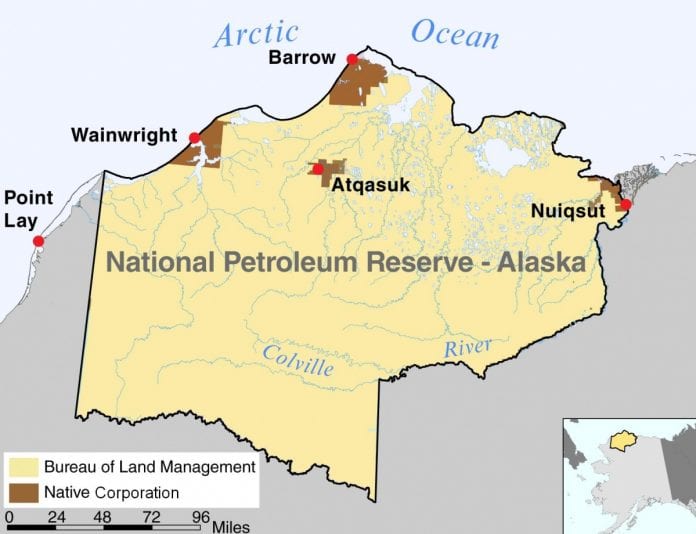By DAN JOLING, Associated Press
ANCHORAGE — Two lawsuits filed Friday claim the federal government conducted petroleum lease sales without proper environmental review in a part of northern Alaska known for its wildlife.
The Bureau of Land Management on Dec. 14 conducted the largest-ever lease offering within the National Petroleum Reserve-Alaska, putting out for bid 900 tracts covering 16,100 square miles (41,700 sq. kilometers), roughly the size of New Hampshire and Massachusetts combined.
In the first lawsuit, five environmental groups said the BLM relied on an environmental review preceding a 2013 NPR-A management plan for the lease sale. Federal law for lease sales, the lawsuit said, required an updated environmental review of the specific land to be offered in a sale, and how wildlife and habitat would be affected.
“The Trump Administration is in such a rush to sell off our public lands to the oil and gas industry that it isn’t even taking the time to comply with the law,” Suzanne Bostrom, an attorney for Trustees for Alaska, an environmental law firm representing the groups, said in a statement.
In the second lawsuit, filed by environmental law firm Earthjustice, four other environmental groups claimed 2016 and 2017 lease sales in the reserve were illegal because the Interior Department failed to take a hard look at their effects on greenhouse gas emissions and climate change.
Email requests for comment from the Interior Department and the U.S. Department of Justice were not returned Friday.
The petroleum reserve was created in 1923 by President Warren Harding as an emergency oil supply for the Navy. The reserve is south of the country’s northernmost city, Utqiagvik, formerly Barrow.
The reserve covers 35,625 square miles (92,269 sq. kilometers), about the size of Indiana. There are 189 authorized petroleum leases in the NPR-A.
A management plan for the reserve adopted in 2013 splits its acreage roughly in half between conservation areas and land available for petroleum development. Former Interior Secretary Ken Salazar said at the time that oil companies would have access to nearly three-fourths of the estimated economically recoverable oil in the reserve.
Salazar called the reserve an “iconic place on our Earth,” home to two caribou herds that are hunted by 40 northern and western Alaska Native villages to support a subsistence life.
Polar bears roam the coast. The reserve includes renowned habitat for migratory waterfowl, including black brant, Canada geese and greater white-fronted geese.
In May, Interior Secretary Ryan Zinke signed an order to review the Obama administration management plan. The December lease sale included no land within conservation areas.
However, it offered all other NPR-A land designated by Salazar as available for drilling.
Lisa Baraff, program director for the Northern Alaska Environmental Center, said federal environmental law requires site-specific analysis of the effects of oil development on wildlife, habitat, fish and subsistence use. She said a more general environmental review preceding the 2013 management plan was not sufficient.
The December sale attracted bids on just seven tracts covering 125 square miles (324 sq. kilometers), all submitted jointly by subsidiaries of ConocoPhillips and Anadarko.
The first lawsuit was filed by the Northern Alaska Environmental Center, Alaska Wilderness League, Defenders of Wildlife, Sierra Club and The Wilderness Society.
The second lawsuit was filed by the Natural Resources Defense Council, Center for Biological Diversity, Greenpeace and Friends of the Earth.















